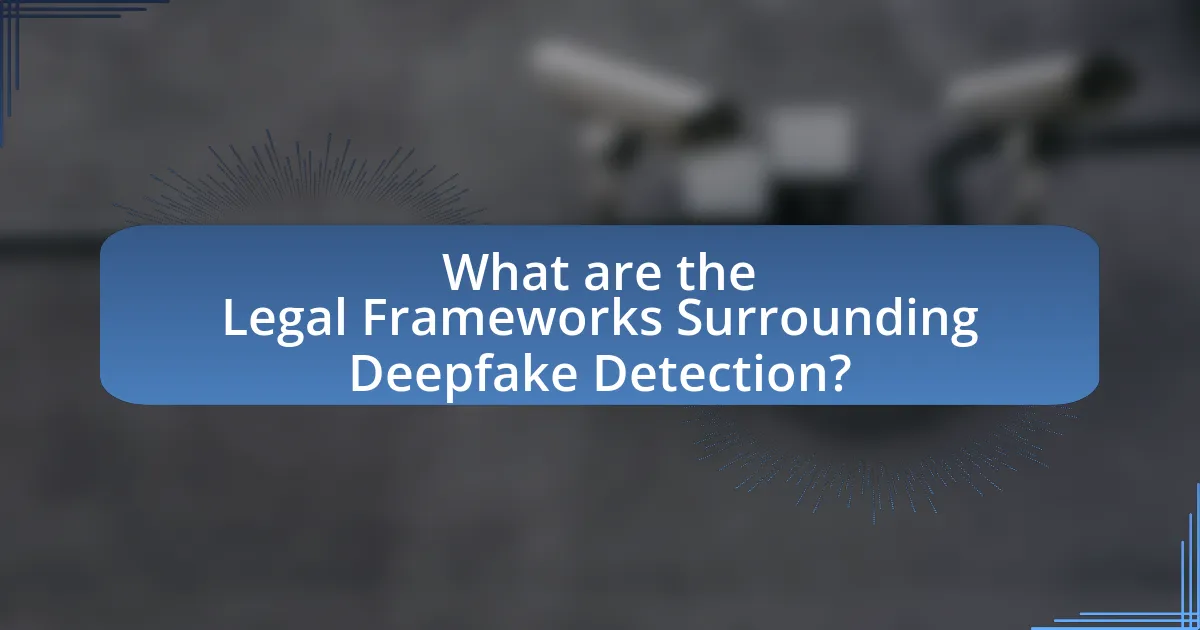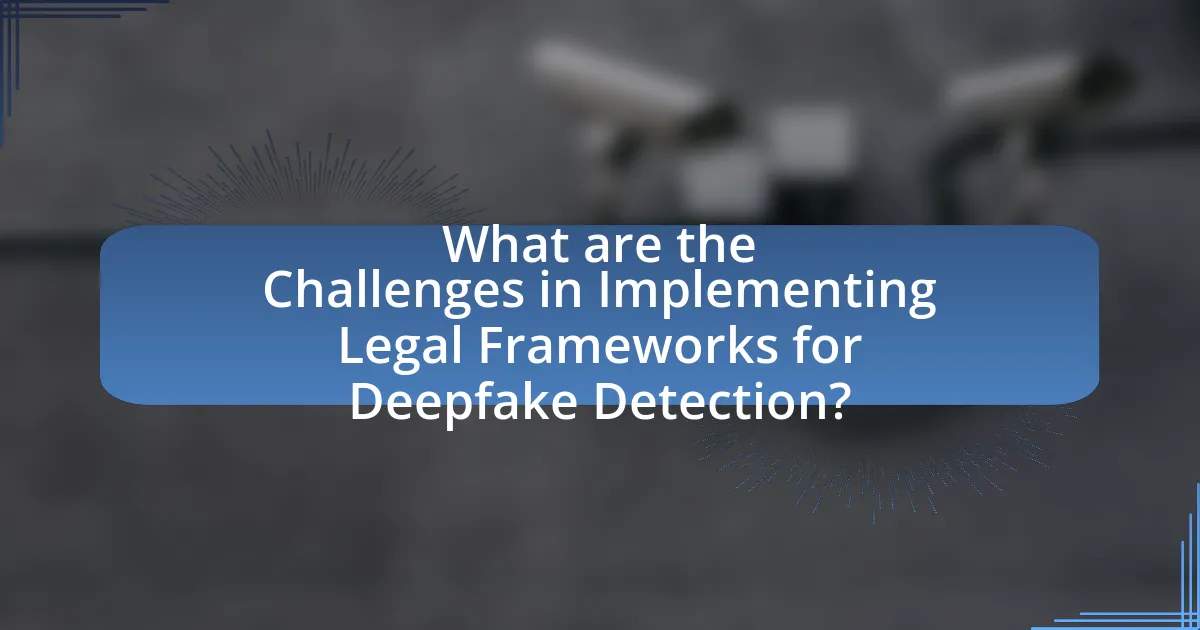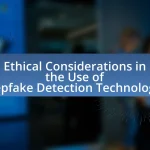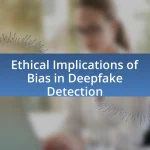The article examines the legal frameworks surrounding deepfake detection, focusing on existing laws related to fraud, copyright, and privacy, as well as emerging legislation specifically targeting deepfakes. It highlights various laws, such as California’s AB 730 and the Malicious Deep Fake Prohibition Act, which criminalize the malicious use of deepfakes and provide legal recourse for victims. The article also discusses the challenges lawmakers face in creating effective regulations, the intersection of deepfake technology with intellectual property and privacy laws, and the importance of establishing accountability to mitigate the risks posed by deepfakes to individuals and society. Additionally, it outlines best practices for navigating these legal frameworks to promote responsible use of deepfake technology.

What are the Legal Frameworks Surrounding Deepfake Detection?
Legal frameworks surrounding deepfake detection primarily involve existing laws on fraud, copyright, and privacy, as well as emerging legislation specifically targeting deepfakes. In the United States, for instance, several states have enacted laws that criminalize the malicious use of deepfakes, such as California’s AB 730, which prohibits the use of deepfakes to harm or defraud individuals. Additionally, the federal government has proposed regulations that address the potential for deepfakes to interfere with elections and spread misinformation. These legal measures aim to provide a basis for prosecuting individuals who create or distribute harmful deepfakes, thereby establishing accountability and protecting individuals’ rights.
How do these legal frameworks address the challenges posed by deepfakes?
Legal frameworks address the challenges posed by deepfakes by implementing laws that criminalize the malicious use of deepfake technology, thereby deterring potential offenders. For instance, several jurisdictions have enacted specific legislation targeting deepfakes, such as California’s AB 730, which prohibits the use of deepfakes to harm, defraud, or intimidate individuals. Additionally, existing laws related to defamation, fraud, and intellectual property are being adapted to encompass deepfake scenarios, providing victims with legal recourse. These frameworks aim to enhance accountability and protect individuals from the potential harms associated with deepfakes, such as misinformation and identity theft.
What specific laws are in place to regulate deepfake technology?
Several specific laws regulate deepfake technology, including the Malicious Deep Fake Prohibition Act of 2018 in the United States, which criminalizes the use of deepfakes for malicious purposes such as defamation or fraud. Additionally, California enacted AB 730 in 2019, making it illegal to use deepfakes to harm or defraud others, particularly in the context of elections and pornography. Furthermore, the European Union’s proposed Digital Services Act aims to address harmful content, including deepfakes, by imposing obligations on platforms to remove such content. These laws reflect a growing recognition of the potential dangers posed by deepfake technology and the need for regulatory measures to protect individuals and society.
How do these laws vary across different jurisdictions?
Laws surrounding deepfake detection vary significantly across different jurisdictions, reflecting diverse legal frameworks and cultural attitudes toward technology and privacy. For instance, in the United States, some states have enacted specific legislation targeting deepfakes, such as California’s law that prohibits the use of deepfakes to harm or defraud individuals, while federal laws are still evolving. In contrast, the European Union is working on comprehensive regulations that address deepfakes within the broader context of digital content and misinformation, emphasizing accountability for platforms. Additionally, countries like China have implemented strict regulations that require real-name registration for online content creators, directly impacting the creation and distribution of deepfakes. These variations illustrate how legal responses to deepfakes are shaped by local societal values, technological advancements, and existing legal structures.
Why is it important to have legal frameworks for deepfake detection?
Legal frameworks for deepfake detection are crucial to establish accountability and protect individuals from potential harm. These frameworks provide guidelines for identifying and addressing the misuse of deepfake technology, which can lead to misinformation, defamation, and privacy violations. For instance, a study by the Brookings Institution highlights that deepfakes can undermine trust in media and democratic processes, emphasizing the need for legal measures to combat their negative impacts. By implementing legal standards, authorities can facilitate the development of detection technologies and ensure that victims have recourse to justice, thereby fostering a safer digital environment.
What potential harms do deepfakes pose to individuals and society?
Deepfakes pose significant harms to individuals and society by facilitating misinformation, damaging reputations, and undermining trust in media. Individuals can suffer from identity theft, harassment, or defamation when their likeness is manipulated in deepfake videos, leading to emotional distress and potential financial loss. For society, the proliferation of deepfakes can erode public trust in legitimate news sources, as seen during the 2020 U.S. elections when manipulated videos were used to spread false narratives. This erosion of trust can destabilize democratic processes and incite social unrest, as people may struggle to discern fact from fiction in an increasingly digital landscape.
How can legal frameworks mitigate these risks?
Legal frameworks can mitigate the risks associated with deepfakes by establishing clear regulations that define the legality of creating, distributing, and using deepfake technology. These regulations can include penalties for malicious use, such as defamation or fraud, thereby deterring individuals from engaging in harmful activities. For instance, laws like California’s AB 730, which criminalizes the use of deepfakes for malicious purposes, provide a legal basis for prosecution and help protect individuals from potential harm. Additionally, legal frameworks can promote transparency by requiring disclosures when deepfakes are used in media, enabling consumers to make informed decisions. This combination of deterrence and transparency fosters a safer digital environment, reducing the risks posed by deepfake technology.

What are the Key Components of Legal Frameworks for Deepfake Detection?
The key components of legal frameworks for deepfake detection include definitions of deepfakes, regulations on the creation and distribution of synthetic media, liability provisions for misuse, and guidelines for transparency and consent. Definitions establish what constitutes a deepfake, which is essential for legal clarity. Regulations may involve prohibiting malicious uses, such as defamation or fraud, and ensuring that creators disclose when content is altered. Liability provisions hold individuals or entities accountable for harm caused by deepfakes, while guidelines for transparency require that users are informed about the nature of the content they are consuming. These components are crucial for addressing the ethical and legal challenges posed by deepfakes, as evidenced by legislative efforts in various jurisdictions, such as California’s law against the malicious use of deepfakes in elections and the proposed federal legislation in the United States aimed at combating deepfake technology.
What types of legislation are relevant to deepfake detection?
Various types of legislation relevant to deepfake detection include privacy laws, intellectual property laws, and anti-fraud statutes. Privacy laws, such as the General Data Protection Regulation (GDPR) in Europe, regulate the use of personal data, which can be implicated in deepfake technology. Intellectual property laws protect the rights of creators against unauthorized use of their likeness or content, which is crucial in cases of deepfakes. Anti-fraud statutes, like the Computer Fraud and Abuse Act in the United States, can be applied to prosecute malicious uses of deepfakes that deceive individuals or organizations. These legislative frameworks collectively address the ethical and legal challenges posed by deepfake technology.
How do intellectual property laws intersect with deepfake technology?
Intellectual property laws intersect with deepfake technology primarily through issues of copyright, trademark, and the right of publicity. Deepfake technology can create realistic audio and visual content that mimics real individuals, potentially infringing on the copyright of original works or violating the trademark rights of brands. For instance, if a deepfake uses a celebrity’s likeness without permission, it may violate that individual’s right of publicity, which protects against unauthorized commercial use of one’s identity. Additionally, the unauthorized use of copyrighted materials in creating deepfakes can lead to legal disputes, as seen in cases where creators of deepfakes have faced lawsuits for copyright infringement. These intersections highlight the need for updated legal frameworks to address the unique challenges posed by deepfake technology in relation to intellectual property rights.
What role do privacy laws play in regulating deepfakes?
Privacy laws play a crucial role in regulating deepfakes by establishing legal boundaries that protect individuals from unauthorized use of their likeness and personal data. These laws, such as the General Data Protection Regulation (GDPR) in Europe, grant individuals rights over their personal information, which can be invoked against the creation and distribution of deepfakes that misrepresent or exploit their identity. For instance, under GDPR, individuals can demand the removal of deepfake content that violates their privacy rights, thereby holding creators accountable for misuse. Additionally, privacy laws can serve as a basis for legal action against those who create deepfakes with malicious intent, reinforcing the need for ethical standards in digital content creation.
How do enforcement mechanisms work within these legal frameworks?
Enforcement mechanisms within legal frameworks for deepfake detection operate through a combination of regulatory oversight, legal penalties, and technological measures. Regulatory bodies establish guidelines that define what constitutes a deepfake and the legal ramifications for creating or distributing them without consent. For instance, laws may impose fines or criminal charges on individuals or entities that violate these regulations, thereby deterring malicious use. Additionally, technological measures such as watermarking and digital signatures can be employed to identify and trace deepfake content, facilitating enforcement actions. These mechanisms are supported by case law and legislative examples, such as California’s AB 730, which specifically addresses the unauthorized use of deepfakes in elections and other contexts, illustrating the legal framework’s commitment to combating this issue.
What agencies are responsible for enforcing deepfake regulations?
The Federal Trade Commission (FTC) and the Federal Bureau of Investigation (FBI) are primarily responsible for enforcing deepfake regulations in the United States. The FTC addresses deceptive practices related to deepfakes under its authority to protect consumers from misleading content, while the FBI investigates criminal activities involving deepfakes, such as fraud and harassment. Additionally, various state-level agencies may also enforce regulations pertaining to deepfakes, particularly in relation to privacy and defamation laws.
How effective are current enforcement strategies?
Current enforcement strategies for deepfake detection are moderately effective but face significant challenges. While some jurisdictions have implemented laws targeting the malicious use of deepfakes, enforcement remains inconsistent and often lacks the necessary technological support. For instance, a study by the Brookings Institution in 2020 highlighted that only a few states in the U.S. have specific legislation addressing deepfakes, leading to gaps in legal recourse. Additionally, the rapid evolution of deepfake technology outpaces the development of corresponding legal frameworks, making it difficult for enforcement agencies to keep up. Thus, while there are efforts in place, the overall effectiveness of current enforcement strategies is limited by legal, technological, and resource constraints.

What are the Challenges in Implementing Legal Frameworks for Deepfake Detection?
The challenges in implementing legal frameworks for deepfake detection include the rapid technological advancement of deepfake creation, the difficulty in establishing clear definitions and legal standards, and the need for international cooperation. Rapid advancements in artificial intelligence enable the creation of increasingly sophisticated deepfakes, making it hard for legal frameworks to keep pace. Additionally, the lack of universally accepted definitions of deepfakes complicates the drafting of laws, as different jurisdictions may interpret the technology differently. Furthermore, deepfakes often cross borders, necessitating international collaboration to effectively regulate and enforce laws, which is hindered by varying legal systems and priorities among countries.
What obstacles do lawmakers face in creating effective regulations?
Lawmakers face several obstacles in creating effective regulations for deepfake detection, primarily due to the rapid technological advancements and the complexity of the issue. The evolving nature of deepfake technology makes it challenging to draft regulations that remain relevant and effective over time. Additionally, lawmakers must navigate the balance between protecting free speech and addressing potential harms caused by deepfakes, which complicates the regulatory landscape. Furthermore, the lack of consensus on definitions and standards for deepfakes hinders the establishment of clear legal frameworks. For instance, a report by the Brookings Institution highlights that the ambiguity surrounding what constitutes a deepfake can lead to inconsistent enforcement and confusion among stakeholders.
How does the rapid evolution of technology complicate legal responses?
The rapid evolution of technology complicates legal responses by outpacing existing laws and regulations, making it difficult for legal systems to effectively address new challenges. For instance, the emergence of deepfake technology has created significant issues related to misinformation, privacy violations, and intellectual property rights, which current legal frameworks often do not adequately cover. As technology advances, the speed at which new forms of digital manipulation appear can lead to legal ambiguities and gaps, hindering timely and appropriate legal action. This is evidenced by the fact that many jurisdictions are still in the process of developing specific laws to address the implications of deepfakes, highlighting the lag between technological innovation and legal adaptation.
What are the limitations of existing laws in addressing deepfake issues?
Existing laws face significant limitations in effectively addressing deepfake issues due to their outdated frameworks, lack of specific definitions, and jurisdictional challenges. Current legal statutes often do not explicitly mention deepfakes, leaving gaps in enforcement against malicious uses such as defamation or fraud. For instance, laws related to copyright and privacy may not adequately cover the nuances of manipulated media, resulting in difficulties in prosecuting offenders. Additionally, the rapid evolution of technology outpaces legislative processes, making it challenging for lawmakers to keep regulations relevant and effective. Jurisdictional issues further complicate enforcement, as deepfake content can be created and distributed across multiple regions, often evading local laws.
How do legal frameworks balance innovation and regulation?
Legal frameworks balance innovation and regulation by establishing guidelines that promote technological advancement while ensuring public safety and ethical standards. For instance, laws governing deepfake technology aim to prevent misuse, such as identity theft or misinformation, while allowing for creative and legitimate uses in entertainment and education. The European Union’s proposed regulations on artificial intelligence, which include provisions for deepfakes, exemplify this balance by categorizing risks and imposing requirements based on the potential harm of the technology. This approach encourages responsible innovation while protecting individuals and society from potential negative impacts.
What are the implications of overly restrictive laws on technological advancement?
Overly restrictive laws hinder technological advancement by stifling innovation and limiting research opportunities. When regulations impose excessive constraints, developers and researchers may face challenges in exploring new technologies, such as deepfake detection, which can lead to a slower pace of progress. For instance, the European Union’s proposed AI regulations could potentially limit the development of AI technologies by imposing stringent compliance requirements, thereby discouraging investment and experimentation in the field. This creates an environment where beneficial technologies may not be developed or deployed, ultimately affecting societal benefits derived from advancements in areas like security, entertainment, and education.
How can laws be designed to promote responsible use of deepfake technology?
Laws can be designed to promote responsible use of deepfake technology by establishing clear regulations that define acceptable and unacceptable uses, imposing penalties for malicious applications, and requiring transparency in the creation and distribution of deepfakes. For instance, legislation could mandate that any deepfake content used for commercial purposes must be labeled as such, thereby informing viewers and reducing the potential for deception. Additionally, laws could incorporate provisions for consent, ensuring that individuals depicted in deepfakes have given permission for their likeness to be used, which aligns with privacy rights. Evidence of the need for such regulations is reflected in the rise of deepfake-related incidents, such as the misuse of technology in creating non-consensual pornography, which has prompted calls for legal action to protect individuals from harm.
What best practices can be adopted for navigating legal frameworks surrounding deepfake detection?
To navigate legal frameworks surrounding deepfake detection effectively, organizations should implement a comprehensive compliance strategy that includes understanding relevant laws, engaging legal experts, and adopting transparent practices. Understanding laws such as the Digital Millennium Copyright Act (DMCA) and state-specific anti-deepfake legislation is crucial, as these laws outline the legal boundaries and consequences of deepfake usage. Engaging legal experts ensures that organizations remain updated on evolving regulations and can interpret complex legal language accurately. Additionally, adopting transparent practices, such as clear labeling of deepfake content and obtaining consent from individuals depicted, can mitigate legal risks and foster trust. These practices are supported by the increasing number of jurisdictions implementing specific regulations aimed at combating the misuse of deepfakes, highlighting the importance of proactive legal compliance.


